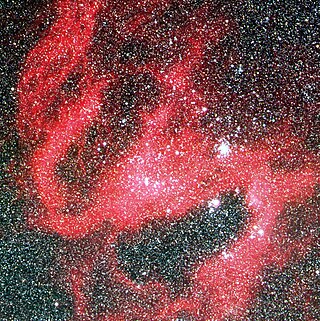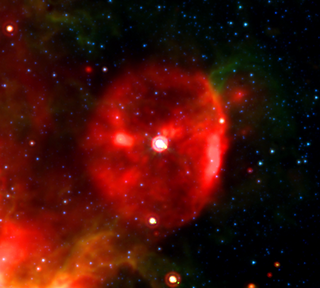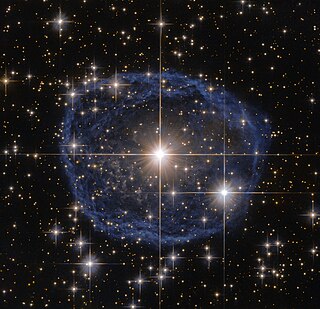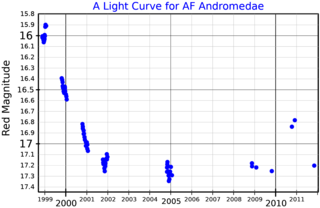
S Doradus is one of the brightest stars in the Large Magellanic Cloud (LMC), a satellite galaxy of the Milky Way, located roughly 160,000 light-years away. The star is a luminous blue variable, and one of the most luminous stars known, having a luminosity varying widely above and below 1,000,000 times the luminosity of the Sun, although it is too far away to be seen with the naked eye.

Luminous blue variables (LBVs) are massive evolved stars that show unpredictable and sometimes dramatic variations in their spectra and brightness. They are also known as S Doradus variables after S Doradus, one of the brightest stars of the Large Magellanic Cloud. They are considered to be rare.

LBV 1806−20 is a candidate luminous blue variable (LBV) and likely binary star located around 28,000 light-years (8,700 pc) from the Sun, towards the center of the Milky Way. It has an estimated mass of around 36 solar masses and an estimated variable luminosity of around two million times that of the Sun. It is highly luminous but is invisible from the Solar System at visual wavelengths because less than one billionth of its visible light reaches us.

P Cygni is a variable star in the constellation Cygnus. The designation "P" was originally assigned by Johann Bayer in Uranometria as a nova. Located about 5,300 light-years from Earth, it is a hypergiant luminous blue variable (LBV) star of spectral type B1-2 Ia-0ep that is one of the most luminous stars in the Milky Way.
Alpha Cygni variables are variable stars which exhibit non-radial pulsations, meaning that some portions of the stellar surface are contracting at the same time other parts expand. They are supergiant stars of spectral types B or A. Variations in brightness on the order of 0.1 magnitudes are associated with the pulsations, which often seem irregular, due to beating of multiple pulsation periods. The pulsations typically have periods of several days to several weeks.

A yellow hypergiant (YHG) is a massive star with an extended atmosphere, a spectral class from A to K, and, starting with an initial mass of about 20–60 solar masses, has lost as much as half that mass. They are amongst the most visually luminous stars, with absolute magnitude (MV) around −9, but also one of the rarest, with just 20 known in the Milky Way and six of those in just a single cluster. They are sometimes referred to as cool hypergiants in comparison with O- and B-type stars, and sometimes as warm hypergiants in comparison with red supergiants.

AG Carinae is a star in the constellation Carina. It is classified as a luminous blue variable (LBV) and is one of the most luminous stars in the Milky Way. The great distance and intervening dust mean that the star is not usually visible to the naked eye; its apparent brightness varies erratically between magnitude 5.7 and 9.0.

A hypergiant (luminosity class 0 or Ia+) is a very rare type of star that has an extremely high luminosity, mass, size and mass loss because of its extreme stellar winds. The term hypergiant is defined as luminosity class 0 (zero) in the MKK system. However, this is rarely seen in literature or in published spectral classifications, except for specific well-defined groups such as the yellow hypergiants, RSG (red supergiants), or blue B(e) supergiants with emission spectra. More commonly, hypergiants are classed as Ia-0 or Ia+, but red supergiants are rarely assigned these spectral classifications. Astronomers are interested in these stars because they relate to understanding stellar evolution, especially star formation, stability, and their expected demise as supernovae.

HD 168607 is a blue hypergiant and luminous blue variable (LBV) star located in the constellation of Sagittarius, easy to see with amateur telescopes. It forms a pair with HD 168625, also a blue hypergiant and possible luminous blue variable, that can be seen at the south-east of M17, the Omega Nebula.

NGC 2363-V1 is a luminous blue variable star in the star-forming region NGC 2363, at the far southwestern part of the irregular galaxy NGC 2366 in the constellation Camelopardalis, near the north celestial pole nearly 11 million light years away from our galaxy. It was discovered in 1996 by Laurent Drissen, Jean-René Roy, and Carmelle Robert while examining images taken by the Hubble Space Telescope Wide Field Planetary Camera 2.

AFGL 2298, also known as IRAS 18576+0341, is a luminous blue variable star (LBV) located in the constellation Aquila, very close to the galactic plane. Its distance is not well known; it may be anywhere between 23,000 and 42,000 light years away from the Earth. Despite being extremely luminous, it is extremely reddened by interstellar extinction, so its apparent magnitude is brighter for longer-wavelength passbands; in fact, in visual wavelengths it is completely undetectable.
R99 is a star in the Large Magellanic Cloud in the constellation Dorado. It is classified as a possible luminous blue variable and is one of the most luminous stars known.

HDE 316285 is a blue supergiant star in the constellation Sagittarius. It is a candidate luminous blue variable and lies about 6,000 light years away in the direction of the Galactic Center.

WR 31a, commonly referred to as Hen 3-519, is a Wolf–Rayet (WR) star in the southern constellation of Carina that is surrounded by an expanding Wolf–Rayet nebula. It is not a classical old stripped-envelope WR star, but a young massive star which still has some hydrogen left in its atmosphere.

V1936 Aquilae is a blue supergiant and candidate Luminous blue variable located in the nebula Westerhout 51, in the constellation Aquila, about 20,000 light years away. The star was originally identified as a massive star in 2000, and was thought to be an O-type supergiant. However, subsequent analyses have shown it to be not O but B-type, as well as being possibly an LBV.

AF Andromedae is a luminous blue variable (LBV), a type of variable star. The star is one of the most luminous variables in M31, the Andromeda Galaxy.
HD 37836 is a candidate luminous blue variable located in the Large Magellanic Cloud and one of the brightest stars in its galaxy.

B324 is a yellow hypergiant in the Triangulum Galaxy, located near the giant H II region IC 142 around 2.7 million light years away. It is the brightest star in the Triangulum Galaxy in terms of apparent magnitude.















